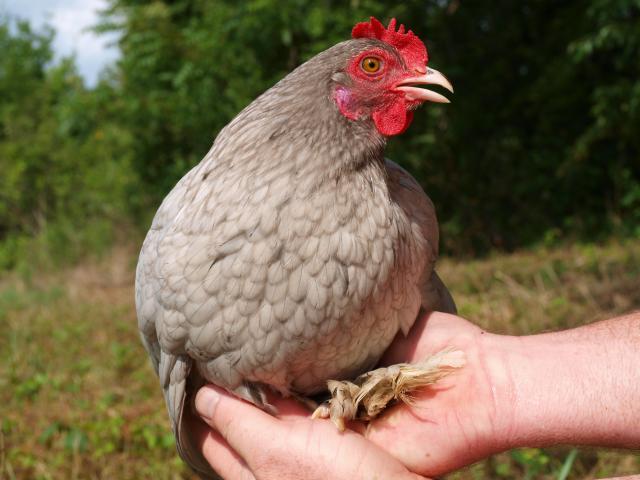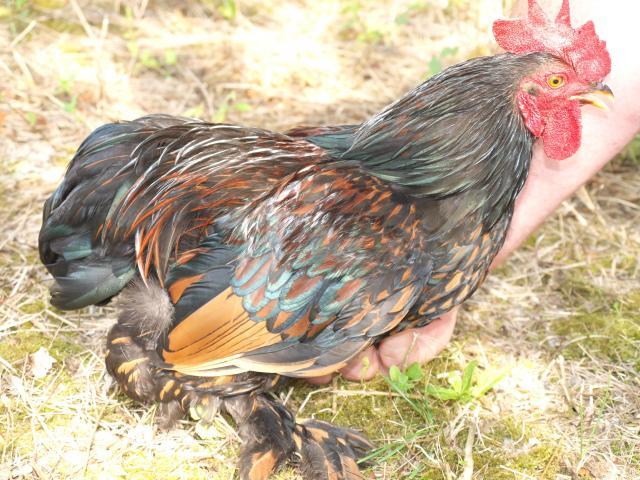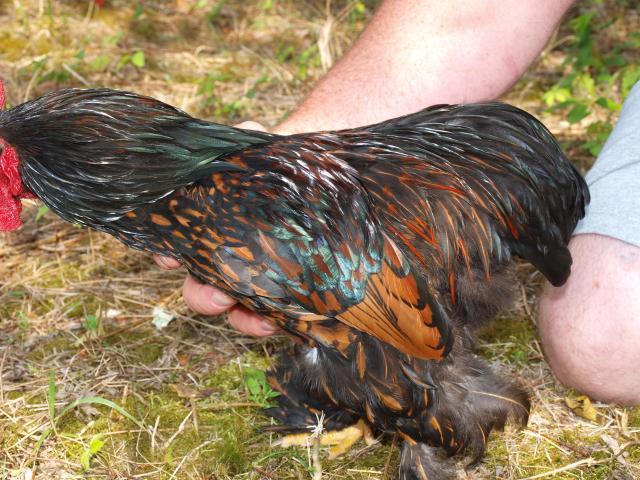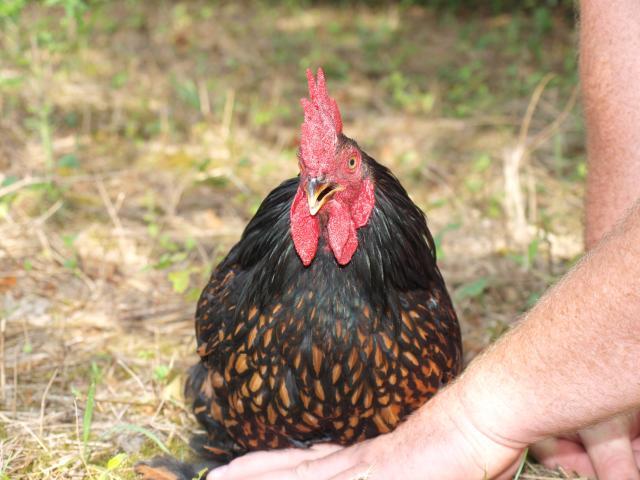I was thinking about entering my bantam Blue Cochins in a county fair show being judged by an ABA judge. However I can't find the standards for my bird anywhere, unless I fork out $50 for the book. Also my bird is 5 months old but has already started laying so is she a pullet or a hen? Are bantam blue cochins a reconized variety? Also I have a nice Golden-laced Cochin Roo same age but part of his comb ( the last spike) has been torn off a little bit, would this be a flaw that would make him not worth entering?
Navigation
Install the app
How to install the app on iOS
Follow along with the video below to see how to install our site as a web app on your home screen.
Note: This feature may not be available in some browsers.
More options
You are using an out of date browser. It may not display this or other websites correctly.
You should upgrade or use an alternative browser.
You should upgrade or use an alternative browser.
ABA Standard
- Thread starter footballcoachmiller
- Start date
I'm not 100% sure of the bantam standards for the Cochins. If you post some pictures, I bet that there's folks on here that could give you some advice that work with bantam Cochins.


- Thread starter
- #3
One more thing she might be a splash would that disqualify her? She is very light but not as light as the splash pictures you see on the internet.
- Thread starter
- #4
I will post pics in a few minutes.
Cochin Breed Characteristics
Bantams - Shape of Female
from the American Bantam Association Standard of Perfection
Origin: Imported to England from China in the 19th Century.
Weight:
Cock: 30 oz
Cockerel: 26 oz Hen: 26 oz
Pullet: 24oz
Shape of Female:
COMB: Single - medium size, straight and upright, set firmly and evenly on head. moderately and evenly serrated, having five regular and distinct points, neatly arched, free from wrinkles or folds.
BEAK: Short, stout at base, curving neatly to point.
FACE: Fine in quality, free from wrinkles folds or bristles.
EYES: Prominent, large in comparison to size of bird.
WATTLES: Small, well rounded,, free from wrinkles or folds.
EAR LOBES: Medium size, elongated oval, fine in texture, free from wrinkles or folds.
HEAD: Short, fairly full in skull, well feathered over eyes, carried so that top of comb will be on a parallel line drawn from top of tail, beak slightly back of line drawn perpendicular with front of breast.
NECK: Short, nicely arched.
HACKLE: Very full, flowing well over cape and shoulders.
BACK: Short, broad from shoulders to cushion, quite rounded its entire length.
CUSHION: Rising very full from back at base of hackle, very large and round; plumage, abundant, flowing over wing tips and into thigh plumage.
TAIL: Short, well spread at base, carried fairly low, well filled underneath with an abundance of soft feathers which are overlapped by tail coverts, the whole forming one unbroken duplex curve with back and cushion.
Main Tail - feathers broad, soft and without hard quills.
Sickles and lesser sickles - broad, soft, rounded, without hard quills.
Coverts - abundant, almost hiding main tail feathers.
WINGS: Small, closely folded, carried very high, above thighs.
Shoulders and fronts - concealed by hackle and breast feathers.
Bows - smooth, exceedingly well rounded.
Coverts - Broad, prominent.
Primaries - Moderate length, concealed by secondaries.
Secondaries - Broad, closely folded, tips concealed by cushion plumage.
BREAST: Carried well forward, extremely full, well rounded, of great breadth and depth.
BODY AND STERN:
Body - medium length, broad, full and well rounded from point of breast to abdomen; abdomen carried well down between the legs, broad and well rounded from breast bone to tail, with great length and abundance of feather.
Stern - very full; fluff, soft and abundant.
LEGS AND TOES:
Legs - short, but not so short as to permit breast feathers to touch the ground where there should be an inch of clearance, stout, parallel to each other without bowing or knock knees, hidden by plentiful fluff, standing out in globular form.
Lower Thighs - moderate length, with abundance of long. soft, outstanding fluff plumage, extending well down the shanks and covering knee or hock joints.
Hocks - covered with soft flexible feathers, curving inward about the hocks, free from vulture-like feathering.
Shanks - short, stout in bone, nicely scaled; plumage long, beginning just below the hocks and covering front and outsides of shanks, from which it should be outstanding, the under part growing out from under thigh plumage and continuing into foot feathering. There should be no marked break in the outlines between the plumage of these section; they should merge naturally into each other and blend together.
Toes - four, straight, well and evenly spread, middle and outer toes completely feathered to ends.
APPEARANCE: Dignified, rather forward and low; head carried on a level with the tail.
DISQUALIFICATIONS:
Vulture Hocks - Bare middle and/or outer toe - Bottoms of feet showing complete absence of yellow in all varieties - Shanks and toes of a color other than hereinafter described under the particular variety.
DEFECTS:
Comb that is oversized, twisted or lopped - High carriage of head - Breast so low that feathers touch the ground - Low wing carriage - Stiffness in tail feathers - High carriage of keel - Crooked breast or keel bone - Overall appearance of being a creeper - Concave surfaces in any section - Lack of down fiber in underfluff - Any semblance of stiltiness.
Bantams - Shape of Female
from the American Bantam Association Standard of Perfection
Origin: Imported to England from China in the 19th Century.
Weight:
Cock: 30 oz
Cockerel: 26 oz Hen: 26 oz
Pullet: 24oz
Shape of Female:
COMB: Single - medium size, straight and upright, set firmly and evenly on head. moderately and evenly serrated, having five regular and distinct points, neatly arched, free from wrinkles or folds.
BEAK: Short, stout at base, curving neatly to point.
FACE: Fine in quality, free from wrinkles folds or bristles.
EYES: Prominent, large in comparison to size of bird.
WATTLES: Small, well rounded,, free from wrinkles or folds.
EAR LOBES: Medium size, elongated oval, fine in texture, free from wrinkles or folds.
HEAD: Short, fairly full in skull, well feathered over eyes, carried so that top of comb will be on a parallel line drawn from top of tail, beak slightly back of line drawn perpendicular with front of breast.
NECK: Short, nicely arched.
HACKLE: Very full, flowing well over cape and shoulders.
BACK: Short, broad from shoulders to cushion, quite rounded its entire length.
CUSHION: Rising very full from back at base of hackle, very large and round; plumage, abundant, flowing over wing tips and into thigh plumage.
TAIL: Short, well spread at base, carried fairly low, well filled underneath with an abundance of soft feathers which are overlapped by tail coverts, the whole forming one unbroken duplex curve with back and cushion.
Main Tail - feathers broad, soft and without hard quills.
Sickles and lesser sickles - broad, soft, rounded, without hard quills.
Coverts - abundant, almost hiding main tail feathers.
WINGS: Small, closely folded, carried very high, above thighs.
Shoulders and fronts - concealed by hackle and breast feathers.
Bows - smooth, exceedingly well rounded.
Coverts - Broad, prominent.
Primaries - Moderate length, concealed by secondaries.
Secondaries - Broad, closely folded, tips concealed by cushion plumage.
BREAST: Carried well forward, extremely full, well rounded, of great breadth and depth.
BODY AND STERN:
Body - medium length, broad, full and well rounded from point of breast to abdomen; abdomen carried well down between the legs, broad and well rounded from breast bone to tail, with great length and abundance of feather.
Stern - very full; fluff, soft and abundant.
LEGS AND TOES:
Legs - short, but not so short as to permit breast feathers to touch the ground where there should be an inch of clearance, stout, parallel to each other without bowing or knock knees, hidden by plentiful fluff, standing out in globular form.
Lower Thighs - moderate length, with abundance of long. soft, outstanding fluff plumage, extending well down the shanks and covering knee or hock joints.
Hocks - covered with soft flexible feathers, curving inward about the hocks, free from vulture-like feathering.
Shanks - short, stout in bone, nicely scaled; plumage long, beginning just below the hocks and covering front and outsides of shanks, from which it should be outstanding, the under part growing out from under thigh plumage and continuing into foot feathering. There should be no marked break in the outlines between the plumage of these section; they should merge naturally into each other and blend together.
Toes - four, straight, well and evenly spread, middle and outer toes completely feathered to ends.
APPEARANCE: Dignified, rather forward and low; head carried on a level with the tail.
DISQUALIFICATIONS:
Vulture Hocks - Bare middle and/or outer toe - Bottoms of feet showing complete absence of yellow in all varieties - Shanks and toes of a color other than hereinafter described under the particular variety.
DEFECTS:
Comb that is oversized, twisted or lopped - High carriage of head - Breast so low that feathers touch the ground - Low wing carriage - Stiffness in tail feathers - High carriage of keel - Crooked breast or keel bone - Overall appearance of being a creeper - Concave surfaces in any section - Lack of down fiber in underfluff - Any semblance of stiltiness.
Pullet or Cockerel - less than 1 year of age
Cock or Hen - Over 1 year of age
Blue is a recognized variety in Cochin Bantams.
Nick in the comb isn't a DQ, but may count a bit against the bird if there were competition and the comb were deciding factor between two birds.
Blue vs. Splash - Distinctly different colors albeit Splash comes from Blue breedings. If you post some pics I think you'll get some help with which color she is.
Cock or Hen - Over 1 year of age
Blue is a recognized variety in Cochin Bantams.
Nick in the comb isn't a DQ, but may count a bit against the bird if there were competition and the comb were deciding factor between two birds.
Blue vs. Splash - Distinctly different colors albeit Splash comes from Blue breedings. If you post some pics I think you'll get some help with which color she is.
Last edited:
- Thread starter
- #7
here is some pics of the pullet



here are some of the roo







here are some of the roo




- Thread starter
- #8
Thanks for the info everyone.


Quote:
Okay, I have a question - I've read the standard many times before, but what does, "The overall appearance of being a creeper" mean? It just sounds funny. My sister and I used to call older guys we caught "checking us out" creepers.

Okay, I have a question - I've read the standard many times before, but what does, "The overall appearance of being a creeper" mean? It just sounds funny. My sister and I used to call older guys we caught "checking us out" creepers.

Last edited by a moderator:
Cochins are supposed to be up off the ground a little, while not being leggy. Creeper refers to the case when they are very short legged and their keels drag the ground, which detracts from the overall appearance and breed type.
New posts New threads Active threads
-
Latest threads
-
-
Is bedding with "baking soda" safe for poultry birds?
- Started by bobsmith2002
- Replies: 1
-
-
-
Threads with more replies in the last 15 days
-
-
Question of the Day - Saturday, July 12th, 2025
- Started by casportpony
- Replies: 164
-
-
-
-
×
